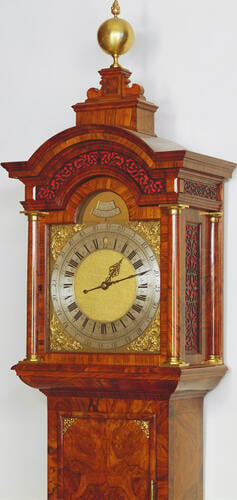-
1 of 253523 objects
Floor standing clock c.1695
Burr walnut, gilt metal, silvered metal, blued steel | 223.0 x 45.5 x 23.6 cm (whole object) | RCIN 57800
-
A long case equation clock of burr-walnut veneer with a break-arch dial and an early example of a sliding hood,, capped with brass ball and finial, and a glazed door covering the dial, below the hood is early convex moulding.
The movement is of a year duration and the escapement, which anchor pallets inverted, is at the base of the movement. The pendulum swings behind the dial and the bob can be seen through a glzed panel in the door.
The clockface has four gilt metal foliate spandrels with putti faces and a silvered chapter ring divided into 24 hours in Roman numerals and an outer minute circle - inscribed 'Apparant Time' - which moves backwards and forwards to record against the fixed hour circule. In the arch the two apertures above the dial record the signs of the zodiac and an eliptic circle showing the sun's position.
Provenance
Made by Thomas Tompion for William III. Selected by George III in 1762 from furnishings at Kensington Palace to be used at the recently acquired Buckingham House.
Thomas Tompion is the most famous of all English clockmakers. The son of a Bedfordshire Blacksmith, Tompion established his business near Fleet Street in 1671. He was closely associated with the mathematician and scientist Robert Hook. The quality and design of Tompion’s clocks, watches and barometers made him one of the most celebrated horologists of his day. Tompion was the inventor of the recoil escapement for clocks and the cylinder escapement in watches. Over his lifetime his workshop produced about 650 clocks and 5000 numbered watches. Tompion is buried in the central aisle of Westminster Abbey.
Other works by Thomas Tompion in the Royal Collection include three barometers and five longcase clocks.
Included in the Pictorial Inventory of 1827-33 – RCIN 934889. The inventory was originally created as a record of the clocks, vases, candelabra and other miscellaneous items from Carlton House, as well as selected items from the stores at Buckingham House, the Royal Pavilion, Brighton, Hampton Court and Kensington Palace for consideration in the refurbishment of Windsor Castle.
-
Creator(s)
(clockmaker)(nationality)Acquirer(s)
-
Medium and techniques
Burr walnut, gilt metal, silvered metal, blued steel
Measurements
223.0 x 45.5 x 23.6 cm (whole object)
Alternative title(s)
Longcase equation clock

